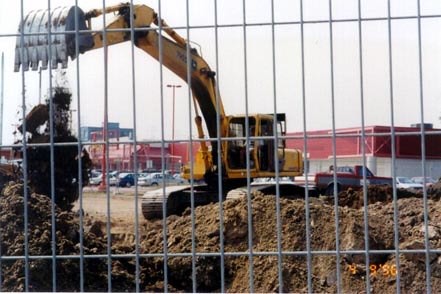
Whether you're a DIYer, a residential general contractor, or even the project manager of a large commercial construction company -- you know the importance of having a quality construction fence up to protect your job site. Not only do you need to protect the site from trespassers who may get injured on the site, you also have to worry about theft of tools, equipment, and materials.
Your construction site fence should be sturdy and, hopefully, installed in-ground. If not, even the temporary fencing set up on stands will help deter certain elements. The site fence must be in place before any tools or materials arrive and before construction/demolition begins. It's best to make sure the construction fence surrounds the entire site, with no more than two access points (gates) to make sure the area is secure. If the entire site is too much, at least surround storage areas, trailers, and offices of the site.
There are many types of construction fences but the best is a high chain link fencing with several rows of barbed wire or rolled barbed wire. With chain link fencing, it's easier for security or police patrols to view the area without entering. It's important to hang "No Trespassing" signs on all construction fences, visible from many directions. This can help with liability issues, too.
Lighting the site can also go a long way in preventing theft and injury from trespassers. The combination of the fencing and the lights can go a long way in deterring the casual or impulse thief from entering the site.
If you need to find a quality Construction Fencing company to install site security fences, consider ConstructionDeal.com. We can match you with quality temporary fencing experts to make sure your equipment and supplies remain safe.
Your construction site fence should be sturdy and, hopefully, installed in-ground. If not, even the temporary fencing set up on stands will help deter certain elements. The site fence must be in place before any tools or materials arrive and before construction/demolition begins. It's best to make sure the construction fence surrounds the entire site, with no more than two access points (gates) to make sure the area is secure. If the entire site is too much, at least surround storage areas, trailers, and offices of the site.
There are many types of construction fences but the best is a high chain link fencing with several rows of barbed wire or rolled barbed wire. With chain link fencing, it's easier for security or police patrols to view the area without entering. It's important to hang "No Trespassing" signs on all construction fences, visible from many directions. This can help with liability issues, too.
Lighting the site can also go a long way in preventing theft and injury from trespassers. The combination of the fencing and the lights can go a long way in deterring the casual or impulse thief from entering the site.
If you need to find a quality Construction Fencing company to install site security fences, consider ConstructionDeal.com. We can match you with quality temporary fencing experts to make sure your equipment and supplies remain safe.



